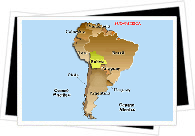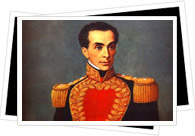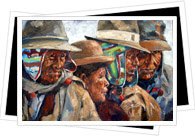
The Plurinational State of Bolivia is a landlocked country, approximately twice the size of France, to the north of Argentina and southwest of Brazil.
The country was named after Simon Bolivar, an independence fighter who liberated much of South America.
An interesting fact to note about Bolivia is that unlike most countries it has has two capital cities.

La Paz is the main administrative capital and at an elevation of 3660m it is the highest capital city in the world. The second capital is Sucre, the constitutional capital and to many Bolivians, the only capital city.
Despite its proximity to the equator, Bolivia's climate and weather can be somewhat varied in its two clear seasons of summer and winter. Summer is from November to March when temperatures are higher and more rain falls. Winter, between April and October sees little rain and lower temperatures. In the highlands the climate is typically cold with temperatures freezing when the sun has set.
The average temperature throughout the year is 7.5 degrees Celsius reaching an average high of 16 degrees in October and November and an average low of -2 in June and July. Bolivia's eastern lowlands enjoy warm tropical weather whereas the high plateaus have cold temperatures and often cold, strong winds.

The Andes have been inhabited for thousands of years but Bolivia's known history goes back 12 centuries to the Tiwanakans who lived to the south of Lake Titicaca at Tiwanaku (Tiahuanaco, on the border of Bolivia and Peru) until about 1000-1200AD. The city of Tiwanaku has been a UNESCO protected world heritage site since 2000.
The Aymara, who still reside in Bolivia, are descendants of the Tiwanakans. The Aymara were conquered by the Inca's who in turn were conquered by the Spanish less than a century later. Approximately 60% of Bolivia's present day population (estimated at just under 10,000,000) are of Amerindian ancestry, the remainder being of a European background or mixed race.
Similarly to most countries in South America, visitors to Bolivia can see the world as it was for ancient civilisations and admire some of their intricate architectural works which have stood in place for hundreds of years, explore the natural world or soak up the Amerindian culture.
Bolivia is one of the most important countries in the world for its variety of nature, as it homes 40% of the world's known plant and animal life. The Noel Kempff Mercado National Park (a UNESCO natural world heritage site) has an evolutionary history of over a billion years and is home to many endangered and threatened species.
Bolivia's history has shown it to be rich in natural resources, despite being a poor country. The Spanish found a mountain of silver at Potosí and in the last century tin was mined heavily to the point that Bolivia was one of the world's main tin exporters. Nowadays Bolivia's main exports are natural gas, zinc, soy beans and sunflower seeds (for making oil).
A unique natural resource to Bolivia is the gemstone, Bolivianita, a fusion of Ametrine and Citrine which has never been found anywhere else in the world.